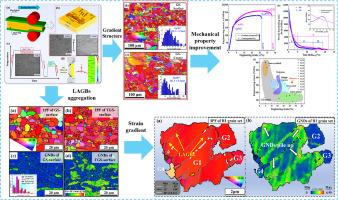当前位置:
X-MOL 学术
›
J. Magnes. Alloys
›
论文详情
Our official English website, www.x-mol.net, welcomes your
feedback! (Note: you will need to create a separate account there.)
Grain boundary-mediated strain response mechanism of AZ31 gradient- structure Mg alloy plate under uniaxial tensile loading
Journal of Magnesium and Alloys ( IF 15.8 ) Pub Date : 2024-08-26 , DOI: 10.1016/j.jma.2024.08.005 Wen Tao Niu, Feng Li, Yuan Qi Li, Zi Yi Wang, Lu Sun
Journal of Magnesium and Alloys ( IF 15.8 ) Pub Date : 2024-08-26 , DOI: 10.1016/j.jma.2024.08.005 Wen Tao Niu, Feng Li, Yuan Qi Li, Zi Yi Wang, Lu Sun

|
The changes in strain gradient induced by grain boundaries are crucial for enhancing the plasticity of gradient magnesium (Mg) alloys. The change of strain distribution influence by grain boundaries during plastic deformation of the gradient structure was examined. In this paper, the gradient structure AZ31 Mg-alloy plate with the surface fine grain (FG) to the center coarse grain (CG) was fabricated using hard plate rolling (HPR). The microstructure and strain distribution of Mg-alloy with a gradient structure were analyzed by electron backscatter diffraction (EBSD) and Digital image correlation (DIC) during uniaxial tensile. The findings indicate that the gradient structure sample (GS sample) displays a uniform strain distribution during the tensile process. Coarse-grain sample (CG sample) have obvious strain concentration, which leads to premature fracture. Based on EBSD characterization, low-angle grain boundaries (LAGBs) accumulates in the CG during plastic deformation. Orientation of CG tends to the (0001) basal. At the same time, the density of geometrically necessary dislocations (GNDs) inside CG has changed, which improves the Heterogeneous deformation induced (HDI) stress of gradient structure. During the uniaxial tensile, LAGBs accumulates in CG and changes the strain distribution of the gradient structure, which induces the accumulation of GNDs, and hence improving the properties of the GS Mg-alloy. These findings unveil the mechanism of strength-plasticity synergism of GS alloys from a new perspective and offer insights into the application of GS in Mg-alloys.
中文翻译:

AZ31梯度结构镁合金板在单轴拉伸载荷作用下的晶界介导应变响应机制
晶界引起的应变梯度变化对于增强梯度镁 (Mg) 合金的塑性至关重要。研究了梯度结构塑性变形过程中晶界对应变分布影响的变化。本文采用硬板轧制 (HPR) 制备了表面细晶 (FG) 到中心粗晶 (CG) 的梯度结构 AZ31 Mg 合金板。通过电子背散射衍射 (EBSD) 和数字图像相关 (DIC) 分析了具有梯度结构的 Mg 合金在单轴拉伸过程中的微观组织和应变分布。结果表明,梯度结构样品 (GS 样品) 在拉伸过程中表现出均匀的应变分布。粗粒样品(CG 样品)具有明显的应变浓度,导致过早断裂。根据 EBSD 表征,在塑性变形过程中,小角度晶界 (LAGB) 在 CG 中积累。CG 的方向趋向于 (0001) 基底。同时,CG 内部几何必要位错 (GND) 的密度发生了变化,这提高了梯度结构的异质变形诱导 (HDI) 应力。在单轴拉伸过程中,LAGBs 在 CG 中积累并改变梯度结构的应变分布,从而诱导 GND 的积累,从而改善 GS Mg 合金的性能。这些发现从新的角度揭示了 GS 合金强度-塑性协同作用的机制,并为 GS 在 Mg 合金中的应用提供了新的见解。
更新日期:2024-08-26
中文翻译:

AZ31梯度结构镁合金板在单轴拉伸载荷作用下的晶界介导应变响应机制
晶界引起的应变梯度变化对于增强梯度镁 (Mg) 合金的塑性至关重要。研究了梯度结构塑性变形过程中晶界对应变分布影响的变化。本文采用硬板轧制 (HPR) 制备了表面细晶 (FG) 到中心粗晶 (CG) 的梯度结构 AZ31 Mg 合金板。通过电子背散射衍射 (EBSD) 和数字图像相关 (DIC) 分析了具有梯度结构的 Mg 合金在单轴拉伸过程中的微观组织和应变分布。结果表明,梯度结构样品 (GS 样品) 在拉伸过程中表现出均匀的应变分布。粗粒样品(CG 样品)具有明显的应变浓度,导致过早断裂。根据 EBSD 表征,在塑性变形过程中,小角度晶界 (LAGB) 在 CG 中积累。CG 的方向趋向于 (0001) 基底。同时,CG 内部几何必要位错 (GND) 的密度发生了变化,这提高了梯度结构的异质变形诱导 (HDI) 应力。在单轴拉伸过程中,LAGBs 在 CG 中积累并改变梯度结构的应变分布,从而诱导 GND 的积累,从而改善 GS Mg 合金的性能。这些发现从新的角度揭示了 GS 合金强度-塑性协同作用的机制,并为 GS 在 Mg 合金中的应用提供了新的见解。


















































 京公网安备 11010802027423号
京公网安备 11010802027423号